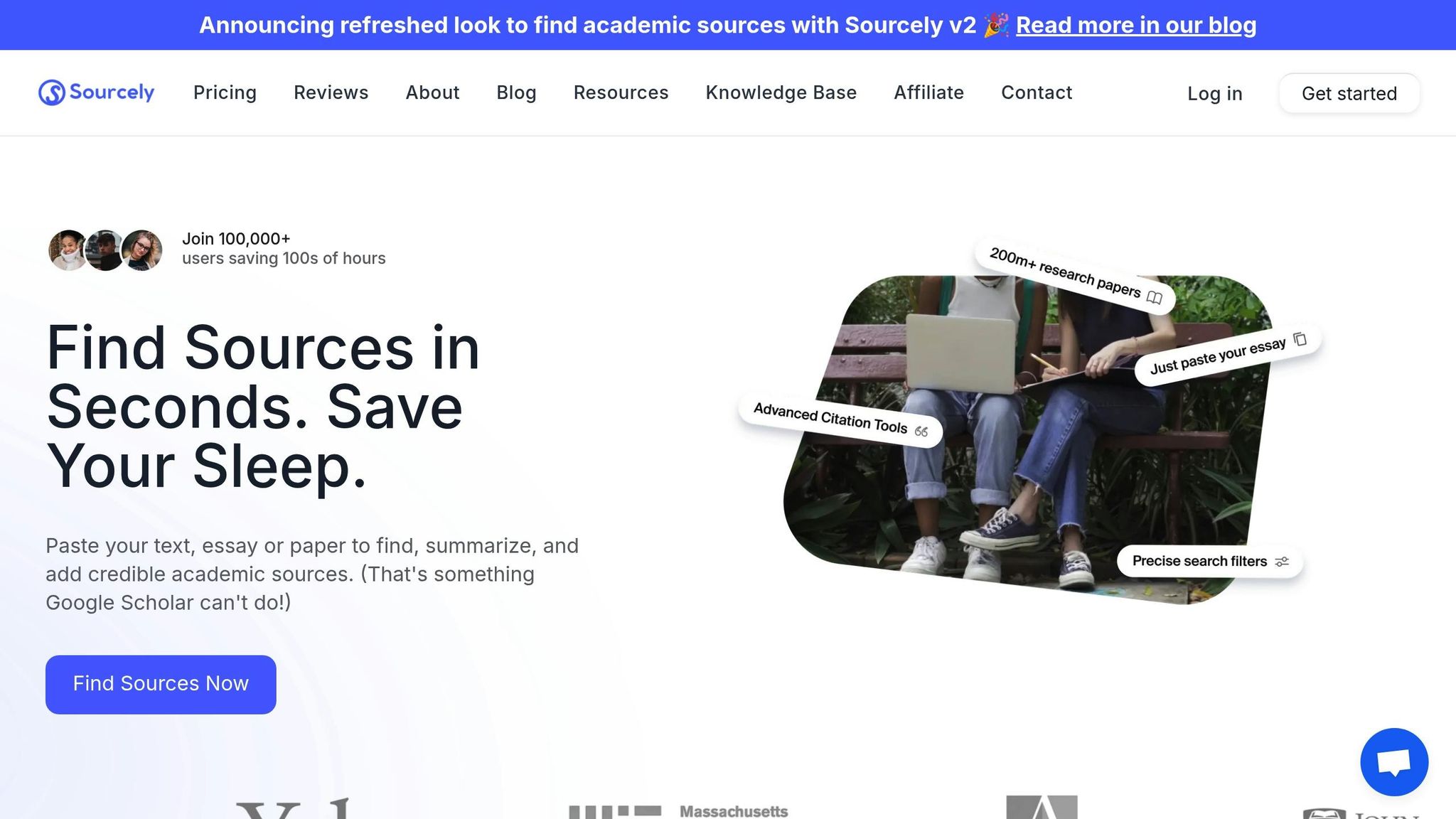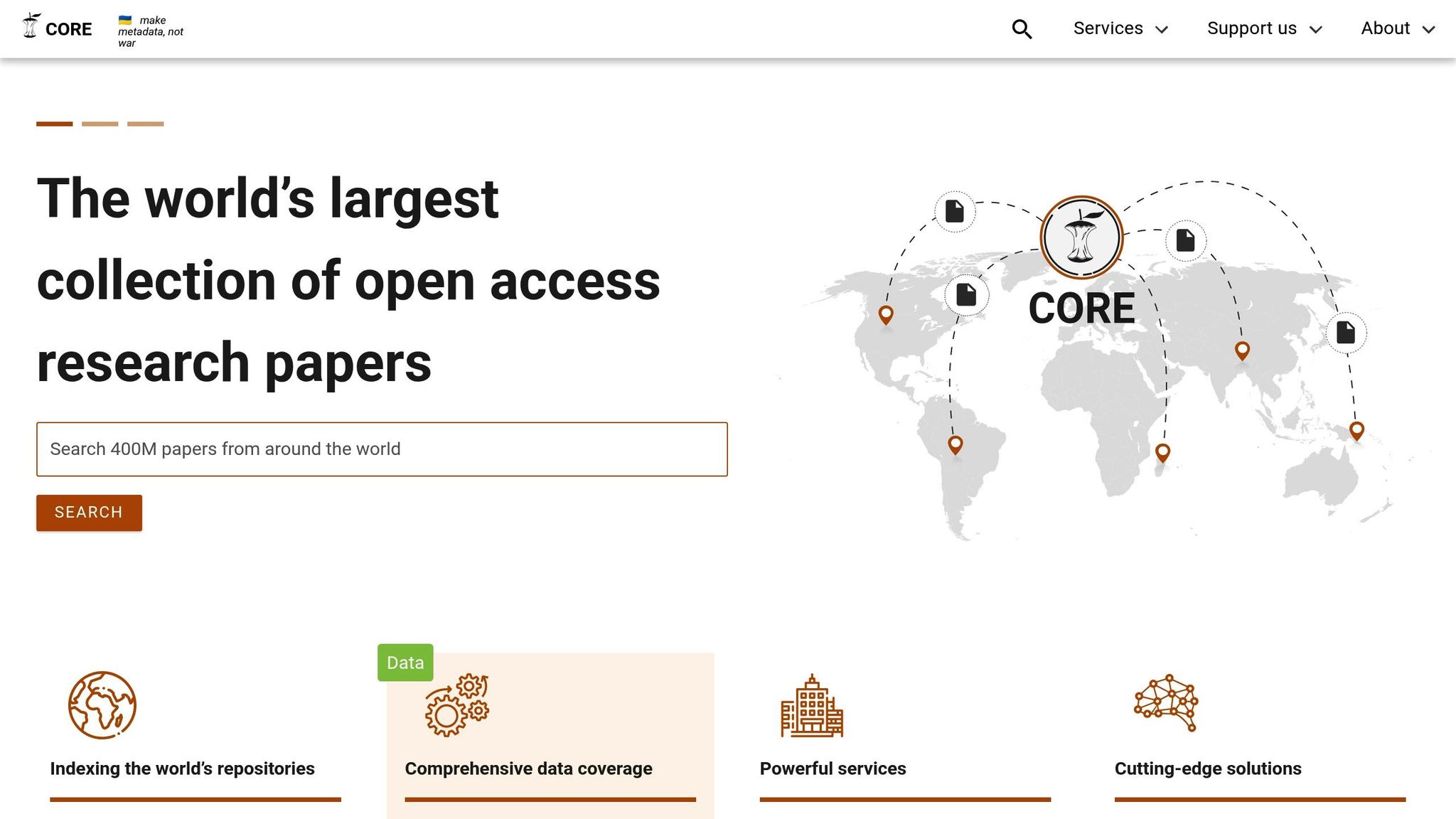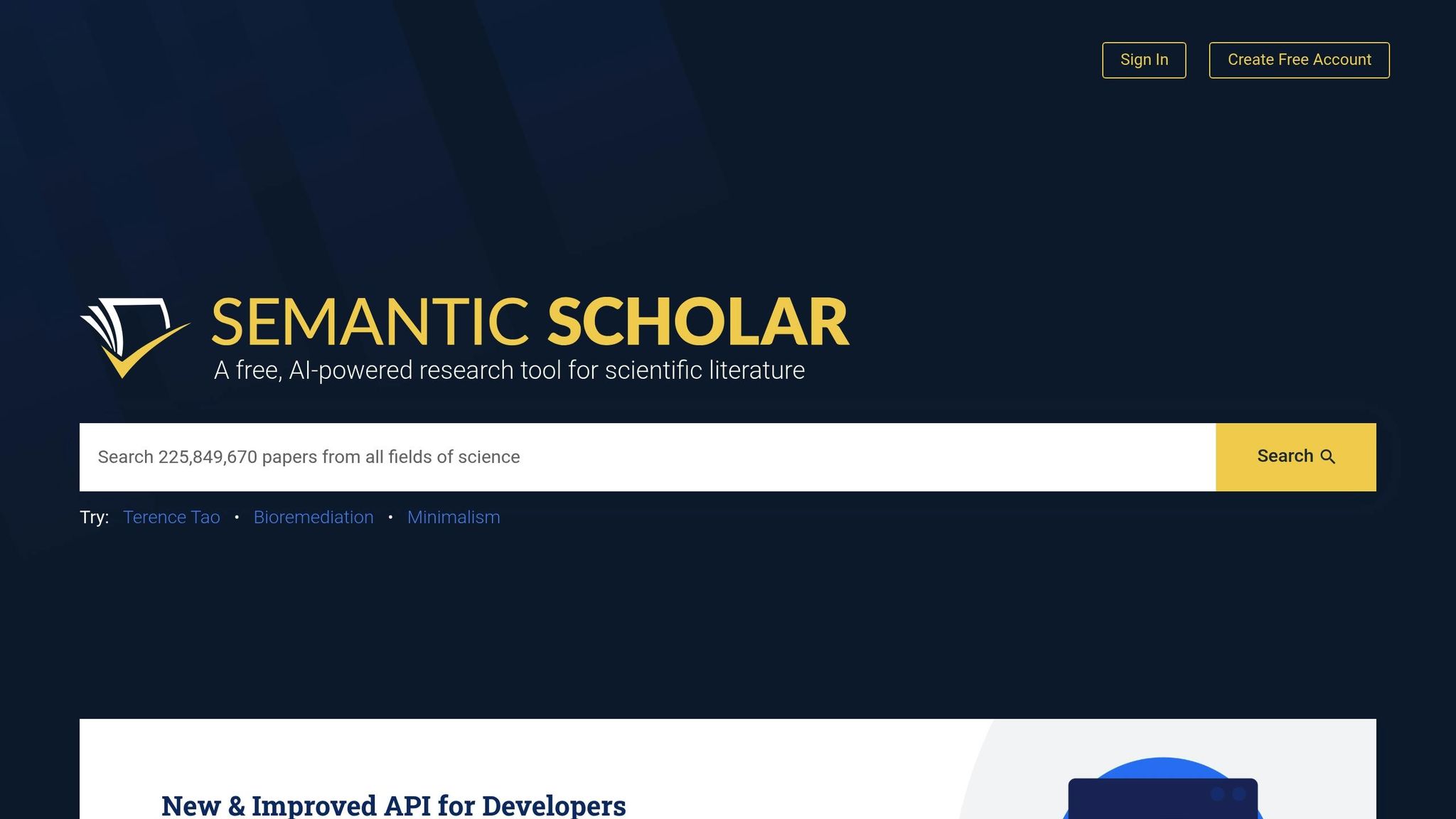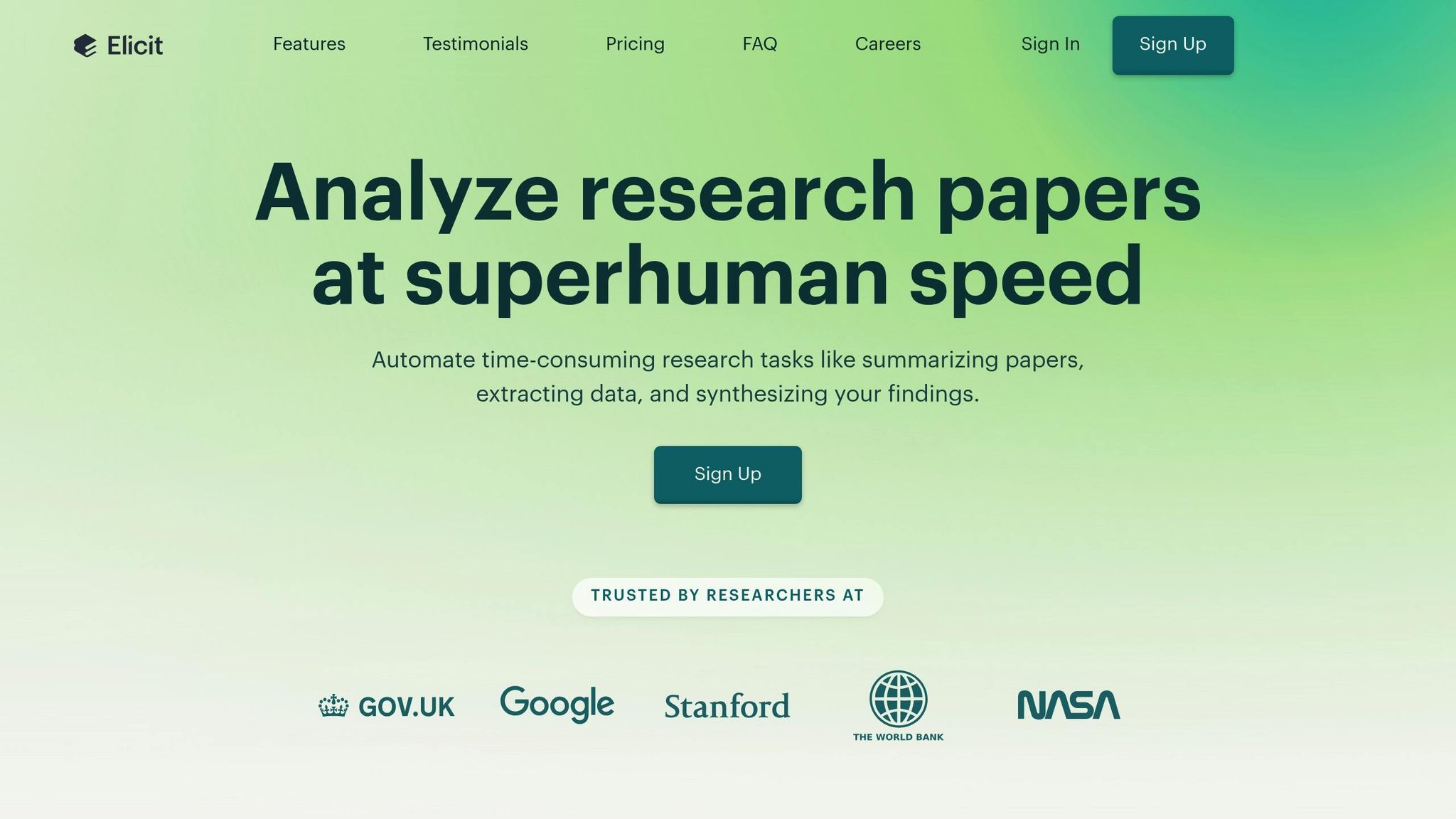
Top Google Scholar Alternatives
Looking for better tools than Google Scholar for academic research? Here’s a quick rundown of the best alternatives that make finding, analyzing, and organizing scholarly content easier and faster.
Key Highlights:
- Sourcely: AI-powered search with citation tracking, smart source discovery, and flexible pricing starting at $7.
- BASE: Curated by librarians, it offers 400M+ records, 60% open access, and multilingual support.
- CORE: Largest open-access database with 412M articles from 13,000 providers worldwide.
- Semantic Scholar: AI-driven platform with features like TLDR summaries and personalized recommendations.
- Science.gov: Free access to U.S. government research from 15 federal agencies.
- ScienceDirect: Elsevier’s platform with 23M+ peer-reviewed articles and AI tools.
- SpringerLink: Access 2,900 journals, 300,000 books, and 10M+ documents.
- Elicit: AI research assistant with conversational search and free tier access.
Quick Comparison:
| Platform | Database Size | Key Features | Access Options |
|---|---|---|---|
| Sourcely | 200M+ papers | AI summaries, citation tracking, flexible pricing | $7 (trial), $17/month, $347 lifetime |
| BASE | 400M+ records | Curated by librarians, 60% open access | Free |
| CORE | 412M articles | Global repositories, 295M full-text free | Free |
| Semantic Scholar | 214M papers | AI summaries, citation ranking | Free |
| Science.gov | 60M+ U.S. government docs | Advanced filters, free access | Free |
| ScienceDirect | 23M+ articles | AI tools, open-access content | Subscription |
| SpringerLink | 10M+ documents | Journals, books, wide subject coverage | Subscription |
| Elicit | 125M papers | Conversational search, free tier | Free, $10/month (Plus plan) |
Each platform caters to different research needs. Choose one based on your field, access requirements, and preferred features.
The Best Google Scholar Alternatives That Even Your ...
How Academic Search Tools Work Today
Modern academic search tools have advanced far beyond basic keyword matching. They now use technologies like natural language processing (NLP) to understand the context of search queries and citation analysis to track the influence of research across fields.
For instance, NLP can recognize that a query like "machine learning applications in healthcare" relates to topics such as "AI in medical diagnosis." Citation analysis maps both direct and interconnected citations, offering researchers a clearer view of how ideas develop and interact across multiple disciplines.
Access Management has also improved. These tools can now bypass paywalls by connecting to institutional subscriptions or open-access repositories, making full-text articles accessible when available.
Key Features of Modern Academic Search Tools
- Context-Aware Search: Semantic query interpretation and ranking based on context.
- Data Extraction and Indexing: Automated metadata extraction, full-text indexing, and PDF parsing for better search results.
- Citation Tracking: Networked citation analysis to identify influential works and track research trends.
- AI-Assisted Reviews: Tools that summarize key findings, methods, and conclusions to simplify literature reviews.
- Integrated Access: Seamless connections to institutional subscriptions, open-access archives, APIs, and browser extensions.
These capabilities make literature reviews faster and more thorough. Coming up, we’ll explore how Sourcely uses NLP and citation tracking to streamline your research process.
1. Sourcely

Sourcely is a tool designed to streamline literature reviews by using advanced NLP and citation-analysis technology. It works with a database of over 200 million scholarly papers, helping users locate and organize relevant sources quickly and efficiently. With AI-powered features like context awareness and cross-citation tracking, it simplifies the research process.
Smart Source Discovery
Sourcely uses context-aware NLP to analyze your manuscript, identify sections that need citations, and suggest appropriate sources. This feature can save significant time during research.
Advanced Search Capabilities
Sourcely offers a range of search filters to refine your results:
- Publication Year: Narrow results by a specific date range.
- Author Credentials: Focus on works by particular scholars or institutions.
- Relevance Ranking: Sort results based on topic alignment.
- Source Type: Select from journals, conference papers, and more.
Research Management
To help organize your research, Sourcely includes tools like:
- Free downloads of full-text PDFs.
- AI-generated summaries for quick insights.
- A citation library with multi-format export options.
Access Options
Sourcely offers flexible pricing plans:
- Try Once: $7 for 2,000 characters of credit.
- Pro: $17/month or $167/year for full access.
- Believer: $347 for unlimited lifetime use.
2. BASE (Bielefeld Academic Search Engine)
BASE, managed by the Bielefeld University Library, focuses on manually curated academic content. Unlike AI-driven tools like Sourcely, BASE relies on human expertise to ensure quality. It indexes over 400 million records from more than 11,000 carefully screened providers.
Each provider is reviewed by Bielefeld librarians, ensuring only servers and journals meeting strict academic criteria are included.
Around 60% of the indexed records are full-text and open access, making it a valuable resource for researchers without institutional subscriptions.
Advanced Search Features
BASE offers several tools to refine your search:
- A multilingual interface supporting over 20 languages
- Access to deep-web content not covered by commercial search engines
- Detailed bibliographic information in search results
- Filters for author, subject, year, language, and license type
Updates and Maintenance
The index is updated twice a month to stay current. Unreliable or closed-access sources are regularly removed to maintain quality.
Up next, CORE brings together repositories from around the globe to centralize research outputs.
3. CORE (COnnecting REpositories)

CORE brings together research from repositories worldwide into one easy-to-use search platform.
As the largest open-access research database, CORE indexes 412 million articles from 13,000 providers across more than 150 countries. It serves 20 million users every month and supports AI-driven tools for advanced semantic search and citation analysis.
Global Repository Network
CORE pulls content from a wide range of sources, including institutional and subject repositories, preprint servers, and open-access or hybrid journals. Impressively, it includes works with and without DOIs - about 50% of indexed works lack DOIs.
Content Accessibility
CORE provides:
- Access to around 295 million full-text research papers for free, with 41 million hosted directly on the platform. These papers represent contributions from over 150 countries.
Quality & Impact
CORE ensures high-quality content through:
- Tools for metadata verification, text and data mining, and open-access compliance to maintain accuracy and accessibility.
- Processes that enhance discoverability and safeguard content from misuse.
CORE’s mission is to index all research while expanding global access. Its tools and features not only gather a massive volume of content but also make it easy for researchers to find and use the materials they need efficiently.
sbb-itb-f7d34da
4. Semantic Scholar

Semantic Scholar uses AI to make research easier and faster. It combines AI-powered reviews, citation tracking, and search tools to help users find and understand academic literature. With a database of 214 million papers and AI-generated summaries for 60 million of them, it highlights key findings and important citations.
AI-Powered Features
- TLDR Summaries: Short, AI-generated summaries that highlight the main points of a paper.
- Influential Citations: Machine learning ranks citations based on their impact.
- Ask This Paper: An AI tool that answers questions using information directly from the paper.
Tailored Research Recommendations
Semantic Scholar offers personalized Research Feeds, which recommend papers based on your library and reading history. You can also rate these recommendations to improve their accuracy over time.
Additional Tools
Management Tools:
- Organize papers using Library Collections.
- Export citations in formats like BibTeX, MLA, APA, or Chicago.
- Add at least five papers to your library to train the AI and improve your Research Feed.
Developer Tools:
- Access the Academic Graph API for custom applications.
- Use the Open Research Corpus (S2ORC) to access full-text metadata and build scholarly tools.
Next, we'll explore how Science.gov expands access to U.S. government research.
5. Science.gov

Science.gov provides access to over 60 million pages of content from 15 U.S. federal agencies, including NASA and the NIH, making it a go-to resource for finding government-funded research at no charge. It compiles studies, technical reports, and scientific data from various fields such as physics, medicine, environmental science, and engineering.
The platform includes advanced search filters, allowing users to refine results by agency, topic, date range, and content type. Additional filters, like research grant numbers, federal programs, and geographic focus, help users locate specific government-backed studies. Its open-access setup works seamlessly with AI-powered indexing and semantic search features, offering a streamlined research experience.
While Science.gov focuses on U.S. government research, ScienceDirect provides a global selection of peer-reviewed journals, enhanced by AI tools for discovery and citation analysis.
6. ScienceDirect

After checking out U.S. government resources on Science.gov, you might want to explore ScienceDirect, a platform from Elsevier. It offers access to over 23 million peer-reviewed articles and book chapters spanning Physical, Engineering, Life, Health, and Social Sciences. The platform also includes AI tools designed to make research more efficient.
ScienceDirect’s AI companion helps researchers by quickly citing, comparing, and highlighting reliable evidence, making literature reviews faster and more effective.
Here’s a breakdown of what ScienceDirect offers:
- 890 open-access journals
- 3.8 million open-access articles
- 48,000 books
- 23 million+ articles and chapters
The platform also features ScienceDirect Topics, which provides detailed explanations for over 430,000 key topics and technical terms directly within the articles.
For advanced searches, ScienceDirect incorporates Scopus citation data and Reaxys chemical structures, allowing for highly precise content discovery. Researchers can set up custom alerts and receive tailored reading recommendations based on their interests and past activity.
Access options include institutional subscriptions, individual purchases, or open-access content. Registered users benefit from remote access and can keep track of their 100 most recently viewed items.
7. SpringerLink

SpringerLink, part of Springer Nature, provides access to a vast collection of academic resources. It features over 2,900 journals, 300,000 books, and more than 10 million documents. Each month, the platform serves 24 million readers with 185 million downloads [10].
The content spans a wide range of fields, including Biological Sciences, Business & Management, Computer Science, Earth & Environmental Sciences, Health Sciences, Mathematics & Statistics, Physics & Astronomy, and Technology & Engineering.
Every year, approximately 3 million authors contribute their work to SpringerLink. These contributions come from publishers like Springer‑Verlag, Urban & Vogel, Steinkopff, and Birkhäuser, making it a centralized hub for Springer publications. Users can search through all books, journals, and book series available on the platform.
8. Elicit

Elicit is an AI-driven research assistant that taps into a database of 125 million papers, allowing users to ask conversational questions instead of relying on rigid keywords to locate relevant studies.
Its automated tools make data extraction and summarization faster and more efficient, cutting team workloads by up to 50% in both time and expenses.
Users have given Elicit an overall rating of 4.6 out of 5, with standout scores in functionality (4.8), ease of use (4.7), and data privacy (4.7).
Elicit offers a free tier with 5,000 credits. The Plus plan starts at $10 per month (billed annually) or $12 per month (billed monthly). It supports exporting in formats like RIS, CSV, or BIB and allows users to upload custom PDFs - making it especially useful for empirical research fields.
Summary and Next Steps
Choose a platform that aligns with your project's needs and how you work. You can apply this approach to platforms like BASE, CORE, Semantic Scholar, and others.
-
Evaluate Your Research Needs
Consider factors like the number of sources required, preferred citation formats, subject focus, compatibility with your existing tools, and budget constraints. -
Align Features with Your Workflow
Look at the platform's AI tools and search capabilities. Compare citation management options, check integration with your current systems, and see if there are features tailored to your field. This helps you make the most of the platform's benefits.
Getting Started
- Create an account and explore AI-based recommendations.
- Track how much time you save and review the accuracy of citations.
To get the best results, connect the platform to library databases and reference managers. This will improve your research process and make managing citations easier.